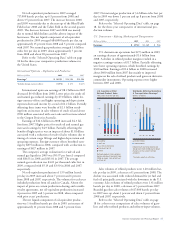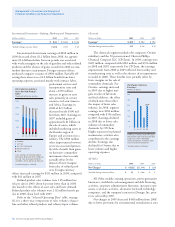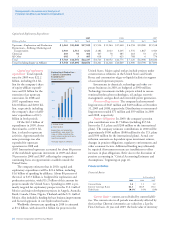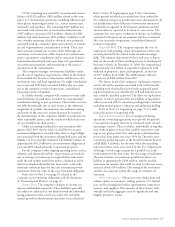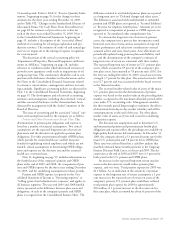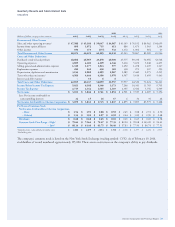Chevron 2009 Annual Report Download - page 27
Download and view the complete annual report
Please find page 27 of the 2009 Chevron annual report below. You can navigate through the pages in the report by either clicking on the pages listed below, or by using the keyword search tool below to find specific information within the annual report.Chevron Corporation 2009 Annual Report 25
FS-PB
Of the remaining year-end 2009 environmental reserves
balance of $1,515 million, $820 million related to the com-
pany’s U.S. downstream operations, including refineries and
other plants, marketing locations (i.e., service stations and
terminals), and pipelines. The remaining $695 million was
associated with various sites in international downstream
($107 million), upstream ($369 million), chemicals ($149
million) and other businesses ($70 million). Liabilities at all
sites, whether operating, closed or divested, were primarily
associated with the company’s plans and activities to remedi-
ate soil or groundwater contamination or both. These and
other activities include one or more of the following: site
assessment; soil excavation; offsite disposal of contaminants;
onsite containment, remediation and/or extraction of petro-
leum hydrocarbon liquid and vapor from soil; groundwater
extraction and treatment; and monitoring of the natural
attenuation of the contaminants.
The company manages environmental liabilities under
specific sets of regulatory requirements, which in the United
States include the Resource Conservation and Recovery Act
and various state and local regulations. No single remediation
site at year-end 2009 had a recorded liability that was mate-
rial to the company’s results of operations, consolidated
financial position or liquidity.
It is likely that the company will continue to incur addi-
tional liabilities, beyond those recorded, for environmental
remediation relating to past operations. These future costs are
not fully determinable due to such factors as the unknown
magnitude of possible contamination, the unknown timing
and extent of the corrective actions that may be required,
the determination of the company’s liability in proportion to
other responsible parties, and the extent to which such costs
are recoverable from third parties.
Under accounting standards for asset retirement obli-
gations (ASC 410), the fair value of a liability for an asset
retirement obligation is recorded when there is a legal obliga-
tion associated with the retirement of long-lived assets and the
liability can be reasonably estimated. The liability balance of
approximately $10.2 billion for asset retirement obligations at
year-end 2009 related primarily to upstream properties.
For the company’s other ongoing operating assets, such as
refineries and chemicals facilities, no provisions are made for
exit or cleanup costs that may be required when such assets
reach the end of their useful lives unless a decision to sell or
otherwise abandon the facility has been made, as the inde-
terminate settlement dates for the asset retirements prevent
estimation of the fair value of the asset retirement obligation.
Refer also to Note 23 on page 67, related to the
company’s asset retirement obligations and the discussion
of “Environmental Matters” on page 26.
Income Taxes The company calculates its income tax
expense and liabilities quarterly. These liabilities generally
are subject to audit and are not finalized with the individual
taxing authorities until several years after the end of the
annual period for which income taxes have been calculated.
Refer to Note 15 beginning on page 53 for a discussion
of the periods for which tax returns have been audited for
the company’s major tax jurisdictions and a discussion for all
tax jurisdictions of the differences between the amount of
tax benefits recognized in the financial statements and the
amount taken or expected to be taken in a tax return. The
company does not expect settlement of income tax liabilities
associated with uncertain tax positions will have a material
effect on its results of operations, consolidated financial
position or liquidity.
Suspended Wells The company suspends the costs of
exploratory wells pending a final determination of the com-
mercial potential of the related crude-oil and natural-gas
fields. The ultimate disposition of these well costs is depen-
dent on the results of future drilling activity or development
decisions or both. At December 31, 2009, the company had
approximately $2.4 billion of suspended exploratory wells
included in properties, plant and equipment, an increase
of $317 million from 2008. The 2008 balance reflected
an increase of $458 million from 2007.
The future trend of the company’s exploration expenses
can be affected by amounts associated with well write-offs,
including wells that had been previously suspended pend-
ing determination as to whether the well had found reserves
that could be classified as proved. The effect on exploration
expenses in future periods of the $2.4 billion of suspended
wells at year-end 2009 is uncertain pending future activities,
including normal project evaluation and additional drilling.
Refer to Note 19, beginning on page 57, for addi -
tional discussion of suspended wells.
Equity Redetermination For oil and gas producing
operations, ownership agreements may provide for periodic
reassessments of equity interests in estimated crude-oil and
natural-gas reserves. These activities, individually or together,
may result in gains or losses that could be material to earn-
ings in any given period. One such equity redetermination
process has been under way since 1996 for Chevron’s inter-
ests in four producing zones at the Naval Petroleum Reserve
at Elk Hills, California, for the time when the remaining
interests in these zones were owned by the U.S. Department
of Energy. A wide range remains for a possible net settle-
ment amount for the four zones. For this range of settlement,
Chevron estimates its maximum possible net before-tax
liability at approximately $200 million, and the possible
maximum net amount that could be owed to Chevron is esti-
mated at about $150 million. The timing of the settlement
and the exact amount within this range of estimates are
uncertain.
Other Contingencies Chevron receives claims from and
submits claims to customers; trading partners; U.S. federal,
state and local regulatory bodies; governments; contractors;
insurers; and suppliers. The amounts of these claims, indi-
vidually and in the aggregate, may be significant and take
lengthy periods to resolve.


